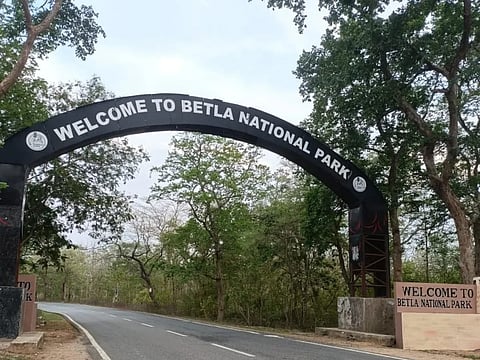
- Destinations
- Experiences
- Stay
- What's new
- Celebrating People
- Responsible Tourism
- CampaignsCampaigns
- Subscribe
- Buy Now

In 1973, the Palamau Tiger Reserve was notified as one of the country's nine original Project Tiger conservation zones to protect India’s national animal. Over a decade later, in 1986, the reserve was folded into what is till today Jharkhand’s only national park.
Betla National Park is a 226.33 sq km expanse of lush green forests, hills, valleys and waterfalls whose name is derived from the animals found there: bison, elephant, tiger, leopard and axis-axis (chital). Located in the Latehar district, the region has been inhabited for centuries, with indigenous tribes like the Oraon and Munda calling it home.
If this is the first time you’ve heard of Betla National Park, you’re missing out on this hidden gem that is a treasure trove of biodiversity. The park boasts a variety of habitats, such as tropical forests, grasslands and wetlands, that are home to a wide range of flora and fauna, including iconic species such as the Indian elephant, the Bengal tiger, chital, bison and the sloth bear.
The vegetation in Betla National Park consists of sal, bamboo, teak, banyan, peepal and other deciduous trees. It is home to more than 970 plant species, some of which are rare or endangered. The North Koel River and its tributaries flow through the northern portion of the park.
Wild animals like tigers, leopards, nilgai, rhesus monkeys, jackals, wolves, wild boars, the Indian pangolin, mongooses and jungle cats live amongst the jungle, to name just a few of the hundreds of species found here.
The park is also a paradise for birdwatchers, with over 200 species of birds recorded within its boundaries. Rare and endemic species like the Malabar pied hornbill, the drongo, the grey-headed swampneck, the red-naped ibis, the crested serpent eagle and the Indian pitta can be spotted amidst the lush foliage, adding to the park's allure.
Hopping on board a Jeep is arguably the most ethical way to observe the variety of wildlife at close range. Accommodating up to six people, the safari operates twice a day (once in the morning and once in the evening).
The experience takes about three hours to complete and covers 35 km of Betla National Park's core and buffer zones, with stops at viewpoints and attractions like the Lodh Falls and Netarhat.
Another way to sightsee is the elephant safari experience. In this case, trained elephants and their mahouts guide visitors through the park in the morning.
The elephant safari covers a distance of about 15 km through the core zone of the park and takes about two hours to complete.
Another alternative to soak in the beauty of Betla National Park is via a boat safari.
Due to its unique ecosystem, the Jharkhand Forest Department, which manages the park, is at the forefront of conservation efforts that focus on habitat restoration, anti-poaching measures, and community engagement initiatives aimed at fostering a deeper connection with nature among visitors and local communities.
Thus, the park plays a crucial role in environmental education and research, providing valuable insights into the region's biodiversity and the challenges it faces. Through initiatives like eco-tourism and interpretation centres, Betla National Park aims to raise awareness about the importance of conservation and inspire future generations to become stewards of the environment.
Birdwatching: Pack a pair of binoculars and try to spot avian species such as peafowl, hornbills, eagles, vultures, parakeets, kingfishers and woodpeckers. You can spot these birds in different parts of the park, especially near water sources or fruit-bearing trees. You can also hear their melodious calls and songs in the morning and evening.
Trekking: Those who enjoy a slower pace of life can embark on a trek on any of the national park's trails. Ranging from easy to difficult, hikers can trek through the forest, hills, waterfalls and ruins of ancient forts. Visitors can also enjoy panoramic views of the park and its surroundings.
Photography: If you are a photography enthusiast, you will find plenty of opportunities to capture some stunning shots in Betla National Park. Experiment with different angles, perspectives, lighting and filters to create some amazing images.
Betla National Park is open from October 1 to June 30. The best time to visit it is from November to March.
Take a flight to Birsa Munda Airport (IXR) in Ranchi or the train to Daltonganj railway station (DTO). Buses and taxis are available from these points to Betla National Park.
